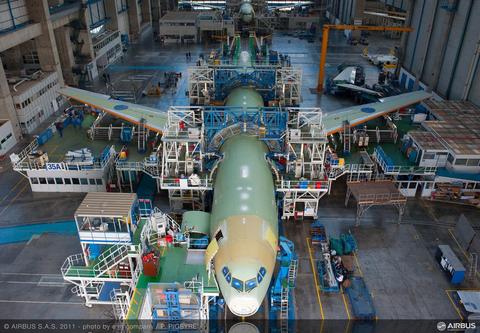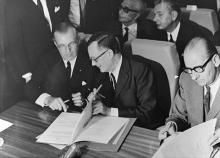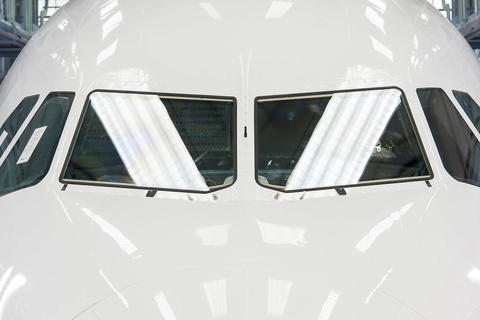In 2009, Airbus celebrated the milestone 40th anniversary of its first aircraft programme’s launch – along with the four decades of innovation and success that followed.
Looking forward to the next 40 years in its role as an industry leader, Airbus built on its positive momentum during 2009-2010 with important orders and deliveries, new aircraft programme developments and key technological advancements.
Record-breaking deliveries and business agreements
Airbus set an all-time company record in 2009 with 498 aircraft deliveries, which included: its handover of the 4,000th A320 Family jetliner – an A319 for Brazilian flag carrier TAM – from the final assembly line in Hamburg, Germany; delivery of the 500th A321 aircraft, received by Air France; and the 30th A380, provided to Emirates.
Air France became the initial European carrier to receive an A380, taking delivery on 30 October 2009 – inaugurating the first commercial flights in November between Europe and the United States with Airbus’ 21st century flagship jetliner.
Lufthansa joined the growing list of A380 airlines with the 19 May 2010 delivery of its no. 1 aircraft – which joined the operator’s expansive Airbus fleet of jetliners ranging from single-aisle A319s, A320s and A321s to wide-body A300s, A330s and A340s.
Airbus handed over its 6,000th aircraft in January 2010, and in doing so underscored the company’s continued role as a leading provider of highly efficient jetliners to customers worldwide. This historic aircraft was an A380 for Emirates, which has flown Airbus-built airliners from its creation in 1985. "It took 19 years for Airbus to produce its first 1,000 aircraft, and just two years for the latest 1,000," said President and CEO Tom Enders at the milestone delivery ceremony in Hamburg. "Our strong order backlog and the continued delivery rates will help us on our way to reaching the 7,000th."
On 18 May 2009, Airbus’ Tianjin facility marked a milestone of its own when the first jetliner built on this Chinese final assembly line – an A320 – completed its maiden flight, taking off from Tianjin International Airport for a 4 hr. 14 min. airborne evaluation. This same A320 was delivered on 23 June 2009 to Dragon Aviation Leasing for operation by Chengu-based carrier Sichuan Airlines, marking the first customer handover of an Airbus jetliner produced outside Europe.
Key agreements signed during the 2009-2010 time period included the largest order in civil aviation history (by U.S. dollar value): 32 additional A380s for Emirates at a value of more than $15.3 billion, announced during the ILA Berlin Air Show in June 2010; and the 500th order for Airbus’ new-generation A350 XWB, booked by Ethiopian Airlines at the November 2009 Dubai Airshow.
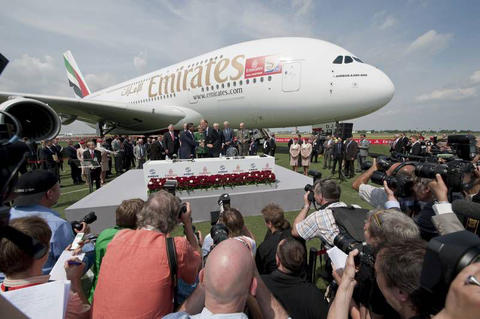
Airbus delivered its 6,000th aircraft – an A380 for Emirates – in 2010.
New aircraft development milestones
From a programme aspect, 2009-2010 brought significant development strides for three future Airbus aircraft: the A350 XWB, the modern mid-size A330-200F freighter and the A400M military airlifter.
Airbus’ A350 XWB programme transitioned from concept to reality in early 2009 with an important milestone: construction start-up of the A350 final assembly line. The 74,000-square metre facility in Toulouse, France, is designed for a parallel work flow capacity of more than 10 A350s per month.
Later that year, an initial composite panel for the long-range A350 XWB was manufactured in a lay-up process at Airbus' Nantes, France facility. With a surface area of 36 square metres, this centre wing-box panel – entirely made of carbon – was the largest "monobloc" composite panel ever manufactured at the site.
Another new Airbus aircraft, the A330-200F, received its Type Certification from the European Aviation Safety Agency at the conclusion of a successful 200-hour flight test campaign with both available engine types – the Pratt & Whitney PW4000 and Rolls-Royce Trent 700. The certification milestone occurred in April 2010, and paved the way for the freighter’s delivery start-up, targeted for later in the year.
Airbus' multi-role A400M airlifter performed a highly successful maiden flight in late 2009, initiating a 3,700-hr. test and certification campaign in advance of its future service entry. Powered by four 11,000-shp. turboprop engines, the no. 1 A400M lifted off from Seville Airport in Spain on 11 December 2009 for a 3-hour, 47-minute-long first mission, during which the six-member crew validated a significant portion of the A400M's flight envelope.
The A400M made its public debut during the June 2010 Berlin Air Show. Taking part in the event’s flying display, this airlifter showcased its rapid climb-out capabilities, slow-speed handling qualities and manoeuvrability during flight demonstrations.
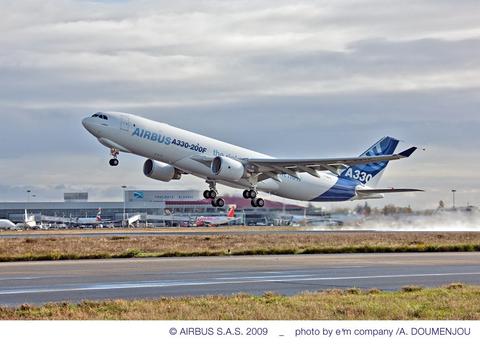
The A330-200F’s first flight was performed on 5 November 2009 from Toulouse, France – the home to Airbus headquarters.
A focus on innovation and technology
Airbus continued its efforts to improve air transport’s overall eco-efficiency during 2009 and 2010 with a series of key milestones – led by an extension of ISO 14001 environmental certification to each of the company’s existing facilities in America and China.
In September 2009, Airbus delivered the first of two A318s equipped with "steep approach" capability to British Airways for operation on long-haul flights between London City and New York's JFK Airport. The A318's ability to land at steeper than usual gradients and its ultra-low noise characteristics make it ideal for operations at downtown airports and in other constrained locations.
Airbus unveiled its advanced Sharklet™ wingtip devices during the 2009 Dubai Airshow with an initial commitment from Air New Zealand. Offered as optional equipment on new production A320-series aircraft, Sharklets provide aerodynamic improvements that result in a number of benefits for operators – including lower fuel burn, reduced emissions and increased range. At the 2010 Berlin Air Show, Finnair became the first operator agreeing to acquire A321s equipped with these fuel-saving devices.
Also showing progress were Airbus-supported environmental initiatives such as Tarmac Aerosave – a joint-venture company for the dismantling of end-of-life aircraft in an entirely “green” manner – which became operational during 2009. In addition, Airbus partnered with the U.N. Environment Programme’s Convention on Biological Diversity to support the Green Wave, a 2010 initiative to raise awareness among young people about the complexity of life on earth and its role in a sustainable future.
In December 2010, Airbus announced its offer of new fuel-saving engines as an option on the A319, A320 and A321. Designated the A320neo, this option applies the advantages of engine technologies that are becoming available in the middle of this decade, providing a choice of CFM International’s LEAP-X and the Pratt & Whitney GTF™ engines. In addition, the A320neo incorporates Sharklet wing tip devices. The A320neo brings the minimum in change for maximum benefit on Airbus’ best-selling A320 Family of jetliners, resulting in a 15 per cent reduction in fuel consumption, two tonnes of additional payload, up to 500 nautical miles of more range, lower operating costs, along with reductions in engine noise and emissions.
In its eco-efficiency roadmap, Airbus continued to support environmental initiatives such as Tarmac Aerosave – a joint-venture company for the dismantling of end-of-life aircraft in an entirely “green” manner – which became operational during 2009. In addition, Airbus partnered with the U.N. Environment Programme’s Convention on Biological Diversity to support the Green Wave, a 2010 initiative to raise awareness among young people about the complexity of life on earth and its role in a sustainable future.
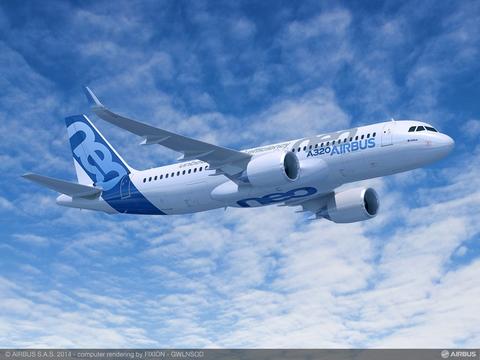
The A320 Family offers new fuel saving engine options.

